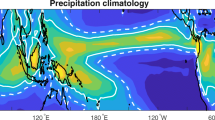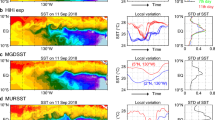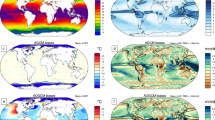Abstract
SST-forced tropical-channel simulations are used to quantify the control of shortwave (SW) parameterization on the mean tropical climate compared to other major model settings (convection, boundary layer turbulence, vertical and horizontal resolutions), and to pinpoint the physical mechanisms whereby this control manifests. Analyses focus on the spatial distribution and magnitude of the net SW radiation budget at the surface (SWnet_SFC), latent heat fluxes, and rainfall at the annual timescale. The model skill and sensitivity to the tested settings are quantified relative to observations and using an ensemble approach. Persistent biases include overestimated SWnet_SFC and too intense hydrological cycle. However, model skill is mainly controlled by SW parameterization, especially the magnitude of SWnet_SFC and rainfall and both the spatial distribution and magnitude of latent heat fluxes over ocean. On the other hand, the spatial distribution of continental rainfall (SWnet_SFC) is mainly influenced by convection parameterization and horizontal resolution (boundary layer parameterization and orography). Physical understanding of the control of SW parameterization is addressed by analyzing the thermal structure of the atmosphere and conducting sensitivity experiments to O3 absorption and SW scattering coefficient. SW parameterization shapes the stability of the atmosphere in two different ways according to whether surface is coupled to atmosphere or not, while O3 absorption has minor effects in our simulations. Over SST-prescribed regions, increasing the amount of SW absorption warms the atmosphere only because surface temperatures are fixed, resulting in increased atmospheric stability. Over land–atmosphere coupled regions, increasing SW absorption warms both atmospheric and surface temperatures, leading to a shift towards a warmer state and a more intense hydrological cycle. This turns in reversal model behavior between land and sea points, with the SW scheme that simulates greatest SW absorption producing the most (less) intense hydrological cycle over land (sea) points. This demonstrates strong limitations for simulating land/sea contrasts in SST-forced simulations.















Similar content being viewed by others
References
Alapaty K, Herwehe JA, Otte TL, Nolte CG, Bullock OR, Mallard MS, Kain JS, Dudhia J (2012) Introducing subgrid-scale cloud feedbacks to radiation for regional meteorological and climate modeling. Geophys Res Lett 39:L24809. doi:10.1029/2012GL054031
Betts AK, Miller MJ (1986) A new convective adjustment scheme. Part II: single column tests using GATE wave, BOMEX, ATEX and arctic air-mass data sets. Q J R Meteorol Soc 112:693–709
Chen F, Dudhia J (2001) Coupling an advanced land-surface/hydrology model with the Penn state/NCAR MM5 modeling system. Part I: model description and implementation. Mon Weather Rev 129:569–585
Chou MD, Suarez MJ (1999) A solar radiation parameterization for atmospheric studies. In: Technical report NASA/TM-1999-104606 vol 15. Technical report Series on Global Modeling and Data Assimilation NASA
Crétat J, Macron C, Pohl B, Richard Y (2011) Quantifying internal variability in a regional climate model: a case study for Southern Africa. Clim Dyn 37:1335–1356
Crétat J, Pohl B, Richard Y, Drobinski P (2012) Uncertainties in simulating regional climate of Southern Africa: sensitivity to physical parameterizations using WRF. Clim Dyn 38:613–634
Dee DP et al (2011) The ERA-Interim reanalysis: configuration and performance of the data assimilation system. Q J R Meteorol Soc 137:553–597
Di Luca A, Flaounas E, Drobinski P, Lebeaupin Brossier C (2014) The atmospheric component of the Mediterranean Sea water budget in a WRF multi-physics ensemble and observations. Clim Dyn 43:2349–2375
Dudhia J (1989) Numerical study of convection observed during the winter monsoon experiment using a mesoscale twodimensional model. J Atmos Sci 46:3077–3107
Evan S, Alexander MJ, Dudhia J (2012) Model study of intermediate-scale tropical inertia-gravity waves and comparison to TWP-ICE campaign observations. J Atmos Sci 69:591–610
Evan S, Rosenlof KH, Dudhia J, Hassler B, Davis SM (2013) The representation of the TTL in a tropical channel version of the WRF model. J Geophys Res Atmos 118:2835–2848
Evans JP, Ekström M, Ji F (2012) Evaluating the performance of a WRF physics ensemble over south-east Australia. Clim Dyn 39:1241–1258
Flaounas E, Bastin S, Janicot S (2011) Regional climate modelling of the 2006 West African monsoon: sensitivity to convection and planetary boundary layer parameterisation using WRF. Clim Dyn 36:1083–1105
Hagos S, Leung R, Rauscher SA, Ringler T (2013) Error characteristics of two grid refinement approaches in aquaplanet simulations: MPAS-A and WRF. Mon Weather Rev 141:3022–3036
Hong SY, Lim JOJ (2006) The WRF single-moment 6-class microphysics scheme (WSM6). J Korean Meteorol Soc 42:129–151
Hong SY, Noh Y, Dudhia J (2006) A new vertical diffusion package with an explicit treatment of entrainment processes. Mon Weather Rev 134:2318–2341
Hourdin F, Grandpeix JY, Rio C, Bony S, Jam A, Cheruy F, Rochetin N, Fairhead L, Idelkadi A, Musat I, Dufresne JL, Lahellec A, Lefebvre MP, Roehrig R (2013) LMDZ5B: the atmospheric component of the IPSL climate model with revisited parameterizations for clouds and convection. Clim Dyn 40:2193–2222
Huffman GJ, Bolvin DT (2013) TRMM and other data precipitation data set documentation. ftp://rsd.gsfc.nasa.gov/pub/trmmdocs/3B42_3B43_doc.pdf
Huffman GJ, Adler RF, Bolvin DT, Gu G, Nelkin EJ, Bowman KP, Hong Y, Stocker EF, Wolff DB (2007) The TRMM multisatellite precipitation analysis: quasi-global, multi-year, combined sensor precipitation estimates at fine scale. J Hydrometeorol 8:38–55
Janjic ZI (1994) The step-mountain eta coordinate model: further developments of the convection, viscous sublayer, and turbulence closure schemes. Mon Weather Rev 122:927–945
Janjic ZI (2002) Nonsingular implementation of the Mellor–Yamada level 2.5 scheme in the NCEP meso model. NCEP office note N 437
Joseph JH, Wiscombe WJ, Weinman JA (1976) The delta-Eddington approximation for radiative flux transfer. J Atmos Sci 33:2452–2459
Kain JS (2004) The Kain–Fritsch convective parameterization: an update. J Appl Meteorol 43:170–181
Kala J, Andrys J, Lyons TJ, Foster IJ, Evans BJ (2015) Sensitivity of WRF to driving data and physics options on a seasonal time-scale for the southwest of Western Australia. Clim Dyn 44:633–659
Kothe S, Ahrens B (2010) On the radiation budget in regional climate simulations for West Africa. J Geophys Res. doi:10.1029/2010JD014331
Leduc M, Laprise R (2009) Regional climate model sensitivity to domain size. Clim Dyn 32:833–854
Li JLF, Waliser DE, Stephens G, Lee S, L’Ecuyer T, Kato S, Loeb N, Ma HY (2013) Characterizing and understanding radiation budget biases in CMIP3/CMIP5 GCMs, contemporary GCM, and reanalysis. J Geophys Res Atmos 118:8166–8184. doi:10.1002/jgrd.50378
Li JLF, Lee WL, Waliser DE, Neelin JD, Stachnik JP, Lee T (2014) Cloud-precipitation-radiation-dynamics interaction in global climate models: a snow and radiation interaction sensitivity experiment. J Geophys Res Atmos. doi:10.1002/2013JD021038
Li R, Jin J, Wang SY, Gillies RR (2015) Significant impacts of radiation physics in the Weather Research and Forecasting model on the precipitation and dynamics of the West African monsoon. Clim Dyn 44:1583–1594
Lim YK, Schubert SD, Reale O, Lee MI, Molod AM, Suarez MJ (2015) Sensitivity of tropical cyclones to parameterized convection in the NASA GEOS-5 model. J Clim 28:551–573
Lin JL (2007) The double-ITCZ problem in IPCC AR4 coupled GCMs: ocean–atmosphere feedback analysis. J Clim 18:4497–4525
Loeb NG, Lyman JM, Johnson GC, Allan RP, Doelling DR, Wong T, Soden BJ, Stephens GL (2012) Observed changes in top-of-the-atmosphere radiation and upper-ocean heating consistent within uncertainty. Nat Geosci. doi:10.1038/NGE
Lucas-Picher P, Caya D, Biner S, Laprise R (2008) Quantification of the lateral boundary forcing of a regional climate model using an aging tracer. Mon Weather Rev 136:4980–4996
Mellor GL, Yamada T (1982) Development of a turbulence closure model for geophysical fluid problems. Rev Geophys Space Phys 20:851–875
Mlawer E, Taubman S, Brown P, Iacono M, Clough S (1997) Radiative transfer for inhomogeneous atmosphere: RRTM, a validated correlated-k model for the long-wave. J Geophys Res 102:16663–16682
Morcrette JJ, Barker HW, Cole JS, Iacono MJ, Pincus R (2008) Impact of a new radiation package, McRad, in the ECMWF Integrated Forecasting System. Mon Weather Rev 163:4773–4798
Nakanishi M, Niino H (2004) An improved Mellor–Yamada level-3 model with condensation physics: its design and verification. Bound Layer Meteorol 112:1–31
Oueslati B, Bellon G (2015) The double ITCZ bias in CMIP5 models: interaction between SST, large-scale circulation and precipitation. Clim Dyn 44:585–607
Pessacg NL, Solman SA, Samuelsson P, Sanchez E, Marengo J, Li L, Remedio ARC, da Rocha RP, Mourão C, Jacob D (2014) The surface radiation budget over South America in a set of regional climate models from the CLARIS-LPB project. Clim Dyn 43:1221–1239
Pohl B, Crétat J, Camberlin P (2011) Testing WRF capability in simulating the atmospheric water cycle over equatorial East Africa. Clim Dyn 37:1357–1379
Praveen Kumar B, Vialard J, Lengaigne M, Murty VSN, McPhaden MJ (2012) TropFlux: air–sea fluxes for the global tropical oceans—description and evaluation against observations. Clim Dyn 38:1521–1543
Raktham C, Bruyère C, Kreasuwun J, Done J, Thongbai C, Promnopas W (2015) Simulation sensitivities of the major weather regimes of the Southeast Asia region. Clim Dyn 44:1403–1417
Ray P, Zhang C, Moncrieff MW, Dudhia J, Caron JM, Leung LR, Bruyère C (2011) Role of the atmospheric mean state on the initiation of the Madden–Julian oscillation in a tropical channel model. Clim Dyn 36:161–184
Reynolds RW, Smith TM, Liu C, Chelton DB, Casey KS, Schlax MG (2007) Daily high-resolution-blended analyses for sea surface temperature. J Clim 20:5473–5496
Samson G, Masson S, Lengaigne M, Keerthi MG, Vialard J, Pous S, Madec G, Jourdain NC, Jullien S, Menkes C, Marchesiello P (2014) The NOW regional coupled model: application to the tropical Indian Ocean climate and tropical cyclone activity. J Adv Model Earth Syst 6:700–722
Skamarock W, Klemp JB, Dudhia J, Gill D, Barker D, Duda M, Huang X, Wang W, Powers J (2008) A description of the advanced research WRF version 3. NCAR technical note NCAR/TN-475 + STR. doi:10.5065/D68S4MVH. http://www2.mmm.ucar.edu/wrf/users/docs/arw_v3.pdf
Ulate M, Zhang C, Dudhia J (2015) Role of water vapor and convection-circulation decoupling in MJO simulations by a tropical channel model. J Adv Model Earth Syst. doi:10.1002/2014MS000393
Wang H, Su W (2013) Evaluating and understanding top of the atmosphere cloud radiative effects in Intergovernmental Panel on Climate Change (IPCC) Fifth Assessment Report (AR5) Coupled Model Intercomparison Project Phase 5 (CMIP5) models using satellite observations. J Geophys Res Atmos 118:683–699
Wehner MF, Reed KA, Li F, Prabhat Bacmeister J, Chen CT, Paciorek C, Gleckler PJ, Sperber KR, Collins WD, Gettelman A, Jablonowski C (2014) The effect of horizontal resolution on simulation quality in the Community Atmospheric Model, CAM5.1. J Adv Model Earth Syst 6:980–997
Wild M, Liepert B (2010) The Earth radiation balance as driver of the global hydrological cycle. Environ Res Lett. doi:10.1088/1748-9326/5/2/025003
Wild M, Folini D, Schär C, Loeb N, Dutton EG, König-Langlo G (2013) The global energy balance from a surface perspective. Clim Dyn 40:3107–3134
Wild M, Folini D, Hakuba MZ, Schär C, Seneviratne SI, Kato S, Rutan D, Ammann C, Wood EF, König-Langlo G (2015) The energy balance over land and oceans: an assessment based on direct observations and CMIP5 climate models. Clim Dyn 44:3393–3429
Wood R (2012) Stratocumulus clouds. Mon Weather Rev 140:2373–2423
Xu J, Small EE (2002) Simulating summertime rainfall variability in the North American monsoon region: the influence of convection and radiation parameterizations. J Geophys Res. doi:10.1029/2001JD002047
Yu L, Jin X, Weller RA (2008) Multidecade global flux datasets from the Objectively Analyzed Air–sea Fluxes (OAFlux) project: latent and sensible heat fluxes, ocean evaporation, and related surface meteorological variables. Woods Hole Oceanographic Institution, OAFlux Project Technical Report. OA-2008-01, Woods Hole, MA
Yuan X, Liang XZ, Wood E (2012) WRF ensemble downscaling seasonal forecasts of China winter precipitation during 1982–2008. Clim Dyn 39:2041–2058
Zamora RJ, Dutton EG, Trainer M, McKeen SA, Wilczak JM, Hou YT (2005) The accuracy of solar irradiance calculations used in mesoscale numerical weather prediction. Mon Weather Rev 133:783–792
Acknowledgments
This work was funded by the European Commission’s 7th Framework Programme, under Grant Agreement Number 282672, EMBRACE Project, and by the Project PULSATION ANR-11-MONU-0010 of the French National Research Agency (ANR). WRF was provided by the University Corporation for Atmospheric Research (http://www2.mmm.ucar.edu/wrf/users/download/get_source.htm). Simulations are performed on the Curie supercomputer, owned by GENCI and operated into the TGCC by CEA. We acknowledge PRACE for awarding us access to the Curie supercomputer thought its 3rd, 5th and 9th calls. We also thank the two anonymous reviewers for their helpful comments.
Author information
Authors and Affiliations
Corresponding author
Rights and permissions
About this article
Cite this article
Crétat, J., Masson, S., Berthet, S. et al. Control of shortwave radiation parameterization on tropical climate SST-forced simulation. Clim Dyn 47, 1807–1826 (2016). https://doi.org/10.1007/s00382-015-2934-1
Received:
Accepted:
Published:
Issue Date:
DOI: https://doi.org/10.1007/s00382-015-2934-1




